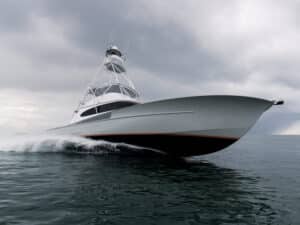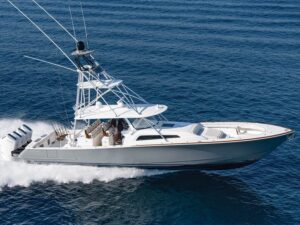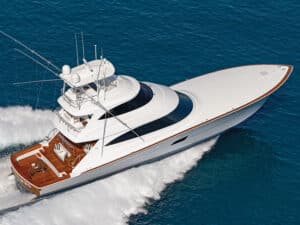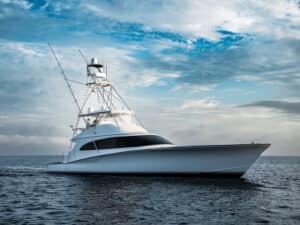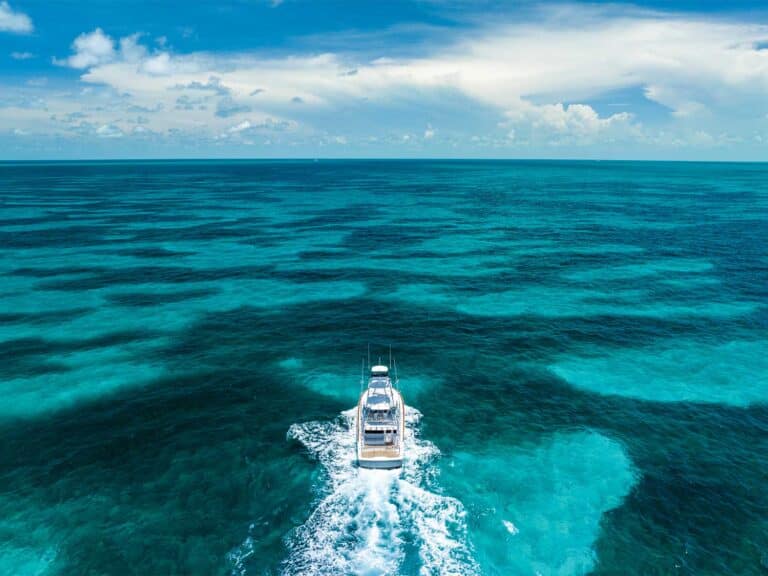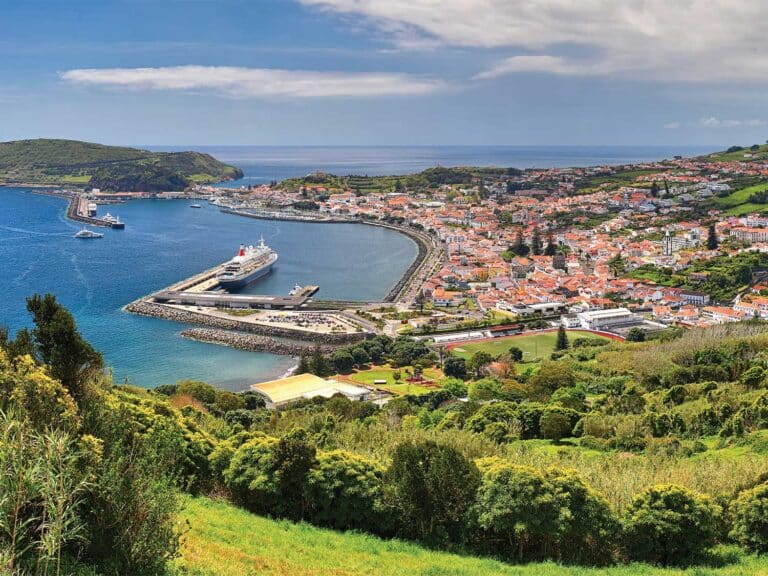The new Viking 55 is dramatically different from other boats in several ways. One, it was built to fill a market niche – hard-core fishing – rather than a size niche. Two, it incorporates features so advanced, so vastly improved over much of what’s available in the production market, that many other boat owners will be green with envy.
Hull No. 1, purchased by the Johnson family of Johnson & Towers engines, will accomplish far more than showcasing the new Detroit/MTU engines. It will make the Johnsons (and any other Viking 55 buyers) loathe to ever switch boats again.
Performance
A front came through the night before we were to fish the new Viking, and a northeasterly wind raised the seas up to 4 to 6 feet. Yet at full speed, a little adjustment to the trim tabs dropped the Viking’s sharp entry, and the ride resembled that of a newly paved highway. And the only way to tell that we were running down-sea was by watching the bow rise and fall. No performance clues, such as lugging engines, lurching or swerving gave it away.
Evidence of Viking’s quantum leap in technology can be found throughout the boat, including in fuel consumption. Wide-open throttle provides a top speed of 37.8 knots at 2,400 rpm burning 116 gph. Cruising speed of about 31 knots uses 70 gph – better than many comparably sized boats. That equates to about a 460-nautical-mile range.
**
Flybridge**
If cleanliness is next to godliness, then the 55’s flybridge is heaven-inspired. The venturi windscreen is gone, and the Strataglas enclosure comes straight down to the flybridge coaming. Additionally, a small insert of clear Lucite has been added to the centerline section of the coaming, allowing the helmsman to see the entire foredeck rather than just the tip of the bow.
The molded fiberglass helm, which contains no pulls or handles to mar the surface, hides all the fuel gauges, emergency shutdowns, fire systems and so on. One long hatch opens to disclose all the radios, breaker switches and other small electronics, while the larger units get flush-mounted behind clear Lucite hatches. There’s even a press-latch hatch in the overhead that hides the recessed teaser reels. The result is as clean a helm as you’ll find in the industry.
Cockpit
As elsewhere, all cabinetry doors have hidden pressure latches for a clean facade. Beneath the salon step you’ll find an insulated drink cooler. The steps have been further refined to extend slightly out and around the cabinetry, making the climb up onto the cabinets (the prime cockpit seating area on any sport-fisherman) easier for less spry anglers. Then too, the cabinets themselves have been enlarged fore and aft by several inches, making for more comfortable seating.
Double-duty seems to be a common theme on the Viking 55. The large cockpit sink has been insulated and can double as a drink or bait box if necessary. Two 33-gallon livewells flank a huge athwartship fish box. Both have been plumbed for a bait well, and the starboard well also has an Eskimo ice maker that can provide up to 600 pounds of crushed ice daily.
Perhaps the greatest change in the 153-square-foot cockpit is under the gunwales. Viking eliminated the small cabinets that barely hold anything. Now gaffs and mops slide into recessed tubes under the portside deck. Electric cords, water hoses, etc., are in the compartment under the starboard-side deck.
Interior
The standard layout offers a centerline double in the bow with a shared head. Moving aft, an over/under double berth follows starboard-side, while the owner’s stateroom opposite includes the second head with shower. A washer/dryer compartment abuts the salon steps to starboard.
The galley is what you’d expect, with an upright refrigerator and Corian counters, and the salon also offers a standard convertible layout of dinette to starboard and L-shaped settee housing rod storage to port.
Engine Room
Just inside the engine-room hatch are the engine gauges, easily viewed without actually entering the room. There’s kneeling space all the way around each engine, though Viking has kept the equipment mounted outboard to a minimum. The company has gloss-painted the entire space except for the varnished teak and holly. The only slightly awkward part is having to step over the athwartship engine-mount stringer as you move forward. Every spigot and knob is labeled, and a built-in tool chest on the forward bulkhead eliminates the need for a loose chest that might fly around in heavy seas.
Viking’s new 55 also has Marine Exhaust straight mufflers rather than the standard lift mufflers. They take up much less room and reduce noise to the point that someone on the flybridge can eavesdrop on conversations in the cockpit.
Construction
Any time you improve either speed or fuel efficiency, you can bet someone has done something to the bottom, and the Viking 55 is no exception. Everything that normally sticks out of the bottom has been faired in, hydrodynamically shaped or eliminated. Bullets in front of the shaft logs, faired-in rudders and flush-mounted thru-hulls make for a totally smooth running surface.
Construction consists of a solid fiberglass bottom, encapsulated wood stringers and balsa or Divinycell coring everywhere else. The cockpit overhang is 6 inches longer than on the older 53, and the cabin house curves inward by the cockpit for a smoother transition and better airflow. The Viking step has also been removed – another sign of the company’s commitment to a clean, uncluttered sport-fishing boat.
